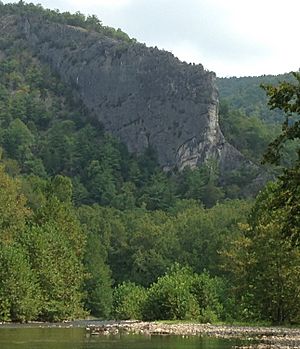Tonoloway Formation facts for kids
The Late Silurian Tonoloway Formation is a type of rock found in parts of the United States. It is mostly made of limestone. You can find this rock unit in Pennsylvania, Maryland, Virginia, and West Virginia. It formed a very long time ago, during the late Silurian period.
Quick facts for kids Tonoloway FormationStratigraphic range: Pridoli |
|
|---|---|

A Tonoloway limestone "fin" known as Blue Rock, Smoke Hole Canyon, West Virginia
|
|
| Type | sedimentary |
| Underlies | Keyser Formation |
| Overlies | Wills Creek Formation |
| Thickness | 250+/-20 m |
| Lithology | |
| Primary | limestone |
| Other | shale |
| Location | |
| Region | Appalachian Mountains |
| Extent | Pennsylvania, Maryland, Virginia, West Virginia |
| Type section | |
| Named for | Tonoloway Ridge, Rock Ford, WV |
| Named by | E. O. Ulrich, 1911 |
Contents
What is the Tonoloway Formation Made Of?
The Tonoloway Formation is a type of bedrock. It is about 250 meters (820 feet) thick. The bottom part, about 50 meters (164 feet) thick, is made of dark gray, thin layers of fine-grained limestone. These layers often have thin sheets of shale mixed in.
Above this, there are about 5 meters (16 feet) of light yellow or olive-gray mudstone and shale. Then comes 75 meters (246 feet) of more layered limestone. This limestone also has thicker beds mixed in. The rest of the rock unit shows repeating patterns of limestone and shale. The very top 20 meters (66 feet) has many different kinds of limestone.
The bottom of the Tonoloway Formation connects smoothly with the Wills Creek Formation. The top also connects smoothly with the Keyser Formation.
How and Where Did It Form?
Scientists believe the Tonoloway Formation formed in a depositional environment that was a shallow ocean. This means the rocks were laid down in water that was not very deep. Over millions of years, layers of mud, silt, and tiny shell pieces built up. These layers then hardened into the limestone and shale we see today.
Where Can You See the Tonoloway Formation?
You can see the Tonoloway Formation in several places. These are called "notable exposures" because they are good spots to study the rock.
- Tonoloway Ridge: This is where the rock unit was first officially described. You can find it in Pennsylvania, Maryland, and West Virginia.
- Near Little Juniata River: About 2 kilometers (1.2 miles) northeast of Bellwood, Pennsylvania.
- Blue Rock: This is a large rock outcrop in the Smoke Hole Canyon in eastern West Virginia. You can see other big rock formations there too.
- Trout Pond: Located in Hardy County, West Virginia.
How Old Is the Tonoloway Formation?
Scientists use a method called "relative age dating" to figure out how old rocks are. This method places the Tonoloway Formation in the late Silurian period. The Silurian period was a long time ago, lasting from about 443 to 419 million years ago. The Tonoloway Formation formed during the very end of this period, known as the Pridoli epoch.

